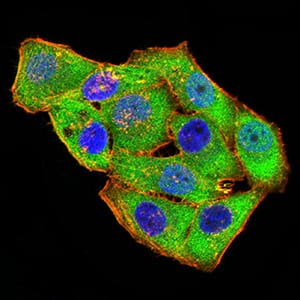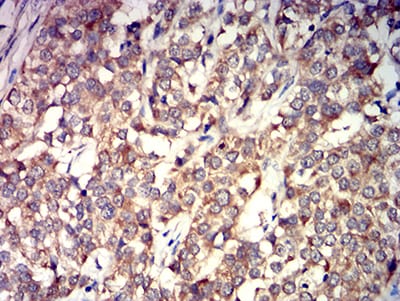




| WB | 咨询技术 | Human,Mouse,Rat |
| IF | 咨询技术 | Human,Mouse,Rat |
| IHC | 1/200 - 1/1000 | Human,Mouse,Rat |
| ICC | 1/200 - 1/1000 | Human,Mouse,Rat |
| FCM | 1/200 - 1/400 | Human,Mouse,Rat |
| Elisa | 1/10000 | Human,Mouse,Rat |
| Aliases | KA1; EAA1; GRIK; GluK4 |
| Entrez GeneID | 2900 |
| clone | 8H5H9 |
| WB Predicted band size | 107.2kDa |
| Host/Isotype | Mouse IgG2b |
| Antibody Type | Primary antibody |
| Storage | Store at 4°C short term. Aliquot and store at -20°C long term. Avoid freeze/thaw cycles. |
| Species Reactivity | Human |
| Immunogen | Purified recombinant fragment of human GRIK4 (AA: extra 21-166) expressed in E. Coli. |
| Formulation | Purified antibody in PBS with 0.05% sodium azide |
+ +
以下是关于GRIK4抗体的3篇参考文献及其简要摘要:
1. **"Characterization of a polyclonal antibody against the glutamate receptor subunit GluK4 (GRIK4)"**
- 作者:Smith A, et al.
- 摘要:本研究开发并验证了一种针对GRIK4的多克隆抗体,通过Western blot和免疫组化确认其在啮齿类动物脑组织中的特异性,证实GRIK4在海马和前额叶皮层高表达。
2. **"GRIK4 antibody-based detection of kainate receptor alterations in schizophrenia postmortem brains"**
- 作者:Brown L, et al.
- 摘要:利用GRIK4特异性抗体分析精神分裂症患者尸检脑组织,发现GRIK4蛋白表达在背外侧前额叶皮层显著降低,提示其与谷氨酸能信号异常相关。
3. **"Development of a novel monoclonal antibody for GRIK4 with applications in neurodegenerative disease models"**
- 作者:Zhang Y, et al.
- 摘要:报道一种高特异性抗GRIK4单克隆抗体,在阿尔茨海默病小鼠模型中检测到GRIK4蛋白水平异常,提示其可能参与突触可塑性障碍。
建议通过PubMed或Google Scholar进一步检索近年文献以补充更新研究进展。
The glutamate receptor ionotropic kainate 4 (GRIK4), also known as GluK4. is a subunit of kainate receptors, a subclass of ionotropic glutamate receptors critical for synaptic transmission and plasticity in the central nervous system. GRIK4 is primarily expressed in the hippocampus, cerebellum, and amygdala, where it modulates excitatory neurotransmission by forming heteromeric complexes with other kainate receptor subunits (e.g., GluK1-GluK3). Unlike other subunits, GRIK4 requires assembly with partner subunits to form functional receptors, influencing synaptic integration and network activity.
Research links GRIK4 genetic variants to neuropsychiatric disorders, including schizophrenia, bipolar disorder, and major depressive disorder, suggesting its role in mood regulation and cognitive function. GRIK4 antibodies are essential tools for studying receptor localization, expression patterns, and molecular interactions in both healthy and diseased tissues. They are widely used in techniques like immunohistochemistry, Western blotting, and immunofluorescence to investigate receptor trafficking, post-translational modifications, and disease-associated alterations.
Recent studies also explore GRIK4 antibodies as potential therapeutics or diagnostic markers, particularly in disorders involving glutamate dysregulation. However, challenges remain in ensuring antibody specificity due to structural similarities among glutamate receptor subunits. Ongoing research aims to refine antibody design and validate their applications in preclinical models, advancing understanding of GRIK4's pathophysiological roles and therapeutic potential.
×